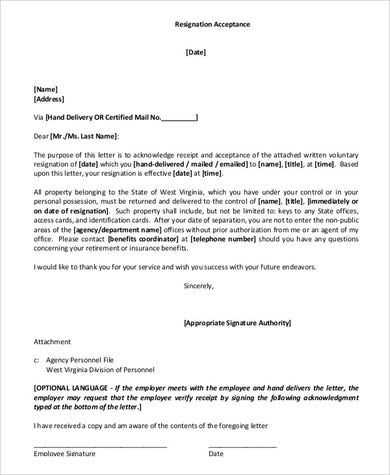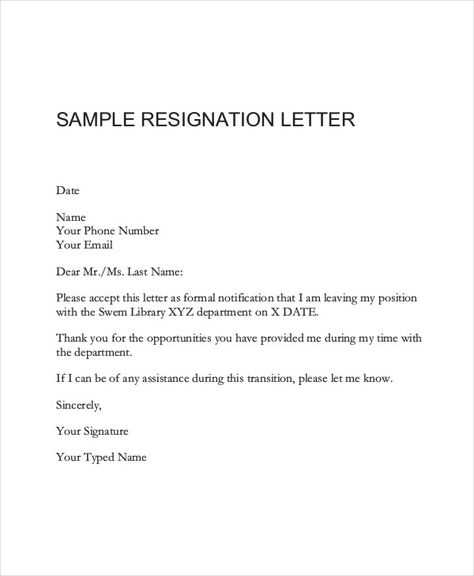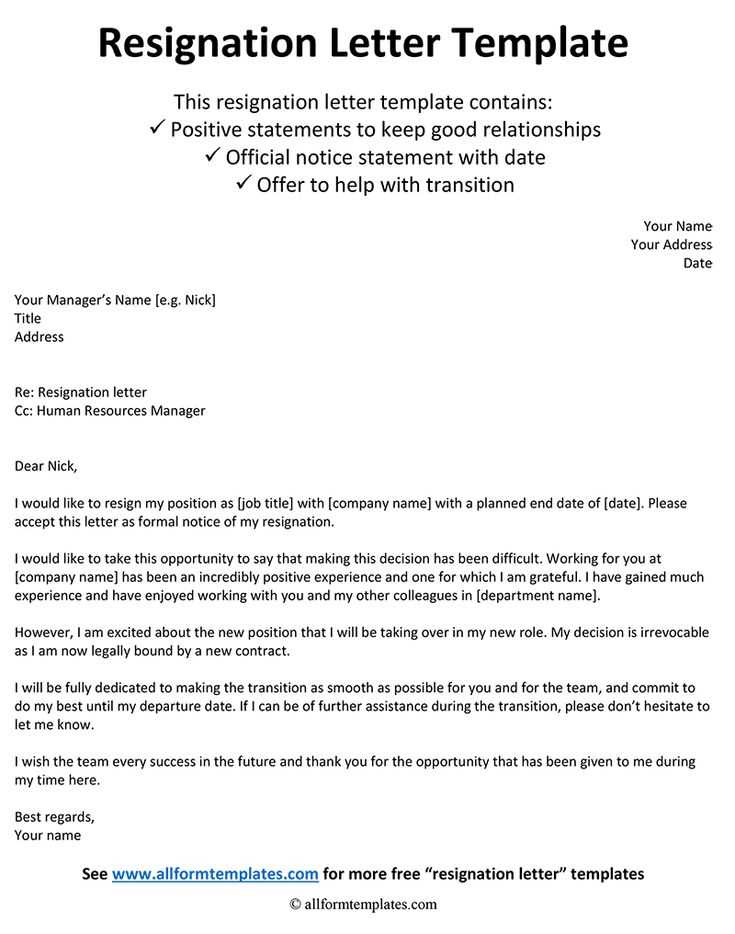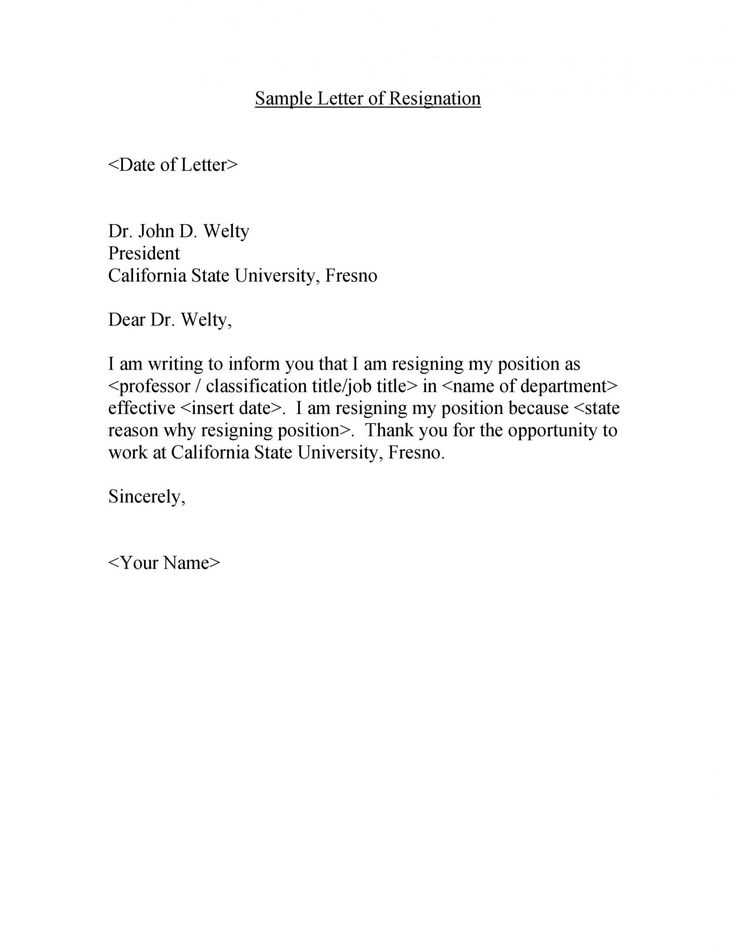Draft Resignation Letter Template for Easy Use

When it’s time to leave your current position, expressing your intentions clearly and professionally is essential. A well-written notice ensures that you part on good terms, maintaining a positive relationship with your employer. This document serves as a formal means of announcing your departure while adhering to company protocols.
Essential Components to Include
A proper exit document should contain certain key details to avoid confusion and maintain professionalism. Below are the crucial elements to consider when crafting your notice:
- Clear Statement of Departure: Indicate your decision to step down and include the date of your intended departure.
- Reason for Leaving: While not mandatory, a brief mention of why you’re leaving can add context and clarity.
- Gratitude and Appreciation: Express thanks for the opportunities provided during your time with the company.
- Transition Plans: Offer to assist with the handover process or provide details on how you plan to transition your responsibilities.
Common Mistakes to Avoid
Even though a notice may seem simple to write, there are some common pitfalls that can leave a negative impression:
- Overly Casual Tone: Keep the tone professional and respectful, avoiding informal language.
- Unclear or Vague Statements: Be concise and to the point. Avoid unnecessary details or ambiguous language.
- Failure to Give Adequate Notice: Be mindful of the notice period required by your company and adhere to it.
Tailoring the Document for Different Scenarios
Each job departure may require a slightly different approach. Whether you’re leaving a short-term position, a high-level role, or transitioning to a new industry, tailoring your exit communication is key. Consider the following adjustments based on your situation:
- Short-Term Roles: For temporary or contract roles, a brief and straightforward exit notice is typically sufficient.
- Higher-Level Positions: Senior employees may wish to include more details about the transition or their contributions to the company.
- Career Change: If you’re moving to a completely different field, expressing your excitement for the future while thanking your employer for the experience is important.
Final Steps After Submitting Your Document

Once you’ve handed in your formal notice, there are a few final actions to take to ensure a smooth transition:
- Notify Your Team: Inform your colleagues and team members about your departure, as appropriate.
- Prepare for Exit Interviews: Some companies conduct exit interviews to gather feedback. Be prepared to discuss your reasons for leaving professionally.
- Wrap Up Your Responsibilities: Complete outstanding tasks or provide thorough handover notes to make the transition easier for your successor.
Why a Professional Exit Document is Essential
When deciding to leave your current role, it’s crucial to communicate your departure clearly and professionally. A formal written announcement helps ensure a smooth transition, maintains your reputation, and allows both you and your employer to plan for the future. It also demonstrates your professionalism and respect for the organization.
Steps to Create a Professional Exit Notice
Creating a well-crafted notice involves several important steps:
- Start with a clear statement: Announce your departure and mention the intended last working day.
- Express appreciation: Thank your employer for the opportunities and experiences gained during your tenure.
- Offer assistance: Show your willingness to help with the transition by training a replacement or completing ongoing projects.
Key Elements to Include
Your written communication should include a few essential elements:
- Introduction: Briefly state the purpose of the document–your decision to leave the position.
- Final working day: Specify the date when you will officially depart.
- Reason for leaving: Although not mandatory, you may want to briefly mention why you’re moving on, if appropriate.
- Appreciation: Express gratitude for the time spent with the company and any learning experiences.
- Transition plans: Offer to help ensure a seamless transition, whether through training or providing assistance in other ways.
Common Mistakes to Avoid When Writing
To maintain a positive and professional tone, avoid these common errors:
- Being overly vague: Clearly state your departure date and any plans for the transition to prevent misunderstandings.
- Leaving on bad terms: Even if your reasons for leaving are negative, maintain a polite and professional tone to ensure a positive final impression.
- Not following company procedures: Adhere to any internal guidelines or protocols for submitting such documents to avoid complications.
How to Tailor Your Notice for Different Positions
Each role may require a different approach when crafting your exit announcement:
- For managerial positions: It’s important to provide detailed transition plans, especially if you’re overseeing key projects or teams.
- For entry-level roles: A short and concise note is usually sufficient, focusing on gratitude and a smooth handover.
- For specialized roles: Ensure you leave comprehensive instructions or documentation for your successor, especially if the role involves specific technical skills.
Submitting Your Formal Notice

Once the document is complete, submit it according to your company’s policies. Typically, this means delivering it to your manager or human resources department. In some cases, a direct conversation may also be required to ensure your departure is handled smoothly.
Next Steps After Sending Your Departure Notice

After submitting your formal communication, follow up by informing your team or colleagues about your departure. Be prepared for an exit interview, where you can provide feedback on your experience with the company. Lastly, complete any remaining tasks or provide handover notes to ensure your transition is as smooth as possible.